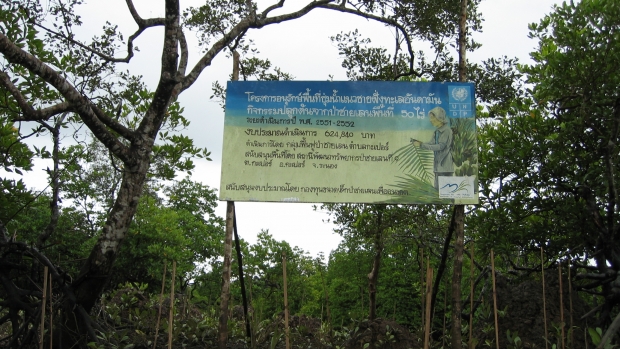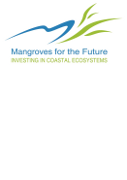Grants :: Small Grant Facilities :: Conserving wetlands on the Andaman coast
Conserving wetlands on the Andaman coast

Conserving wetlands Andaman Coast , Thailand © SSereepaowong 2009, 2009
Objectives
This project aimed to ensure the sustainable use of mangroves, maintain biodiversity, and generate supplementary income for local people, especially from the use of the palm Nypa fruticans. Its specific objectives were:
- To demonstrate how mangrove forest rehabilitation supports community livelihoods;
- To provide communities with knowledge and information on managing mangroves, and raise community awareness of natural resources conservation; and
- To enhance community participation in managing collective mangrove areas and protecting them against pollution and encroachment.
Background
The Mangrove Rehabilitation Network of Kapoe sub-district in Ranong province was established in 2005, after the 2004 Indian Ocean tsunami, by community leaders from Ban Chi Mi, Ban Darn and Ban Banglamphu villages. Its aim initially was to assist the victims of the tsunami and rehabilitate damaged mangrove areas. Since then, the network has operated continuously to conserve mangroves and other coastal resources with support from public and private organisations such as UNDP, IUCN, Farmers Federation Association for Development, Raks Thai Foundation, World Vision, Save the Andaman Network, and the Thai government’s Mangrove Development Station 9.
Target beneficiaries
The main beneficiaries were 120 of the 829 households in the three core villages of the Kapoe Mangrove Rehabilitation Network.
Outputs
- Nine hectares of rehabilitated mangrove area added to the 256-hectare community protected area by planting N. fruticans to provide raw material for income-generating activities.
- Capacity built among community members and youth groups through active participation in conservation activities.
- Conservation awareness of at least 60% of the targeted population enhanced through active and more frequent assembly for community activities.
- Adoption of community regulations for the use of community forests.
- Conservation of juvenile crabs and juveniles of other aquatic species in an area of about one hectare.
Accomplishments and challenges
Participants demonstrated their enhanced capacity for rehabilitation through boundary demarcation, nursery construction, replanting and weeding.
One community adopted an innovative approach to controlling an aggressive climbing weed known as fish bladder (Canscora pentanthera). Fish bladder grows well in the open sun and can smother newly planted mangroves. Villagers discovered, however, that planting Nypa palm can check weed growth and so reduce the time and labour needed for weeding. The palm is also a good source of supplementary income.
One effective community learning mechanism was a raft in Kapoe Canal. Moored among the mangroves, the raft is used as a floating exhibition for youth conservation activities. Behind the raft, on a mudflat, the project demarcated two areas as a black crab bank and a mangrove nursery for demonstration and learning.
Challenges
Crab-eating macaque monkeys (Macaca fascicularis) uprooted newly planted Nypa palms, and crabs also damaged the palm seedlings, making frequent replanting necessary.
Contributions to cross-cutting themes
Climate change
Mangrove forests act as a carbon sink. Coastal mangroves help absorb the shock and reduce the damage caused by extreme weather events.
Lessons Learned
The local wisdom being used by the project was to plant Nypa palm for income, livelihood, ecosystems and weed protection. They discovered that Nypa plam is the best effective plant to serve the ecosystem as the habitat for species, especially black crab as well as inhibiting the growth of weeds, swim bladder.
Project Facts
Country
Location
Koh Yai Rang mangrove area, Kapoe, Ranong, Thailand
Topic
Duration
1st May 2009 to 30th Nov 2010
MFF Grant Amount
US$9,737
Co-financing Partner
The participating communities made cash and in-kind contributions worth US$3,150 and US$4,845 respectively.
Implementing Partner
Mr Wiroj Dejsongpraek
Project Coordinator
Kapoe Mangrove Rehabilitation Network
6/3 Moo 8, Kapoe,
Ranong 85120, Thailand
Tel: +66 81 0891822
“The project changed people’s attitudes and outlook, encouraging
them to be more open and listen more closely to communal concerns.”
— MR WIROJ DEJSONGPRAEK
PROJECT COORDINATOR
Related Images
Related Publications

Mangrove Rehabilitation Network of Tambol Kapoe
Author: MFF Thailand
Posted on: 4th Dec 2013
Category:
Size: 418 KB

